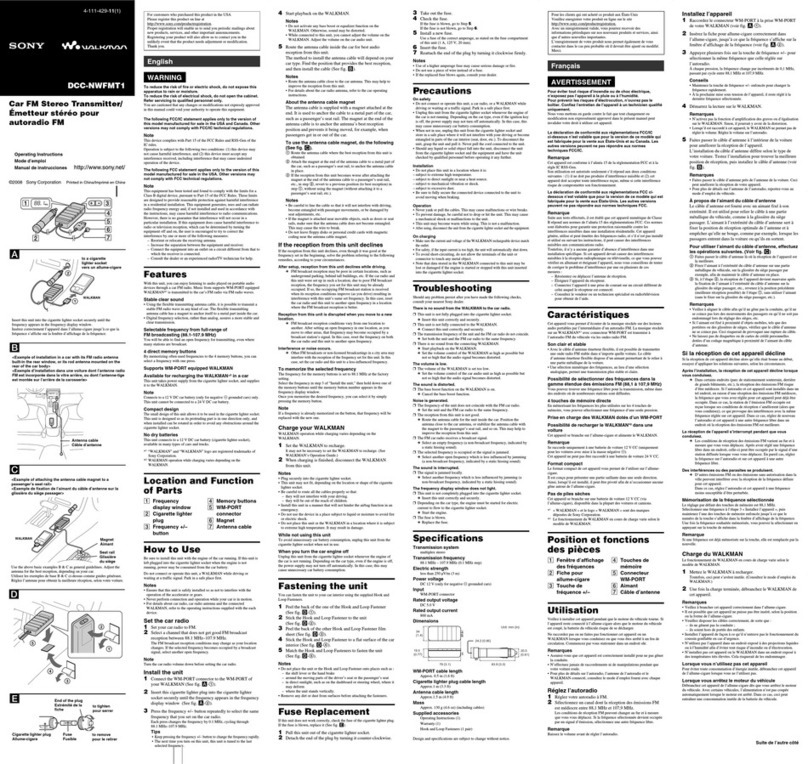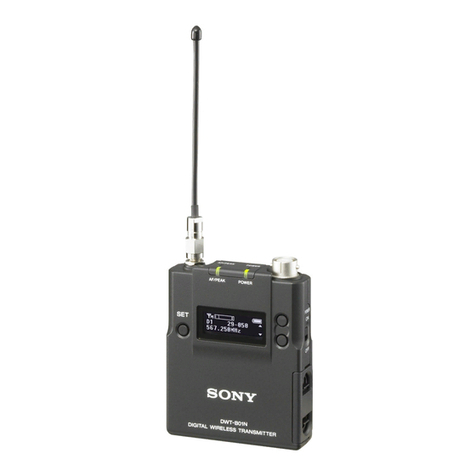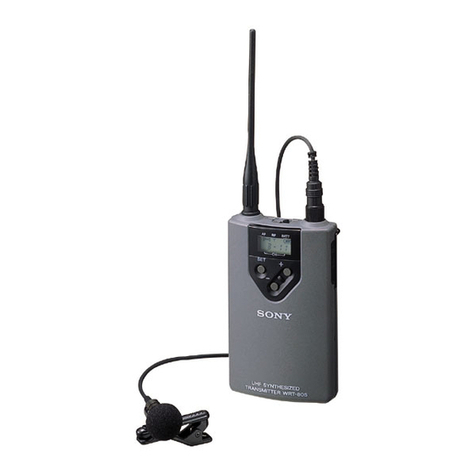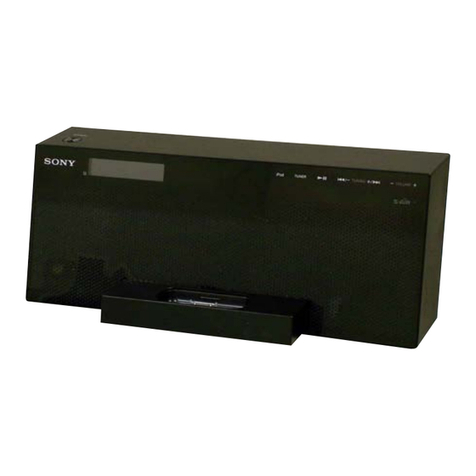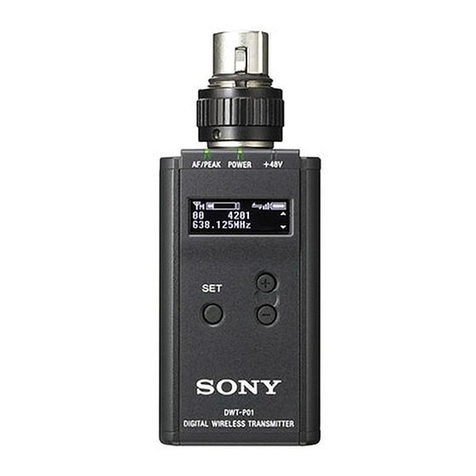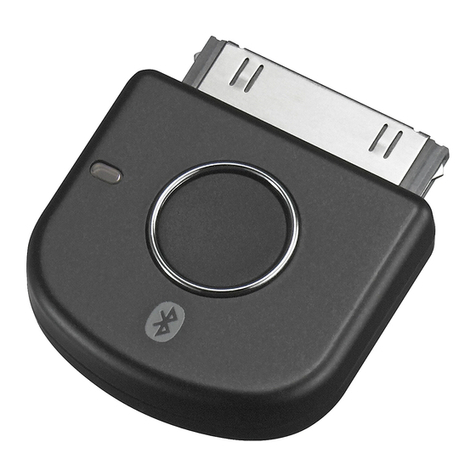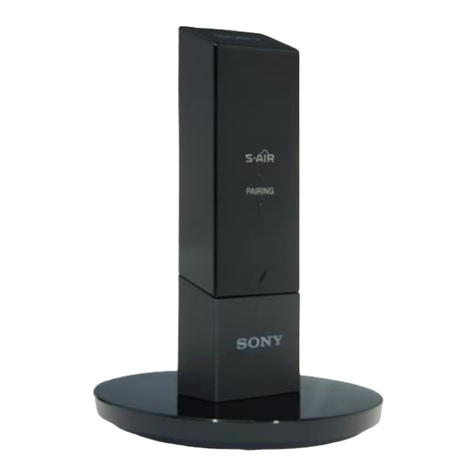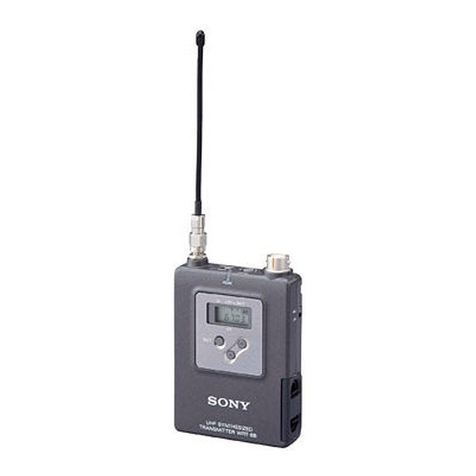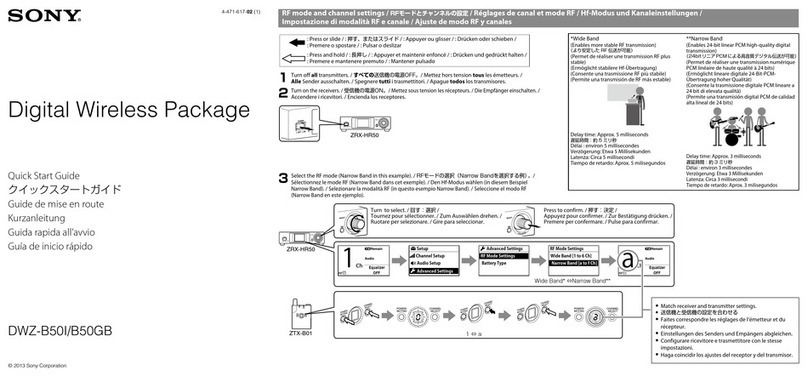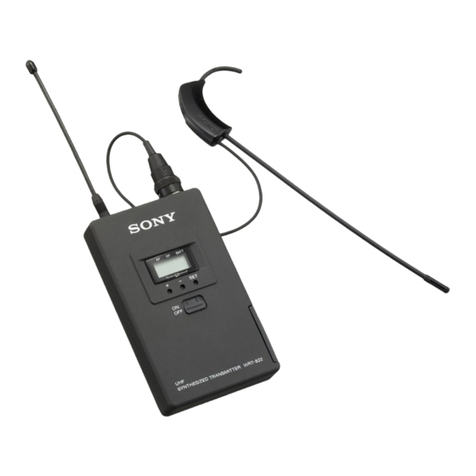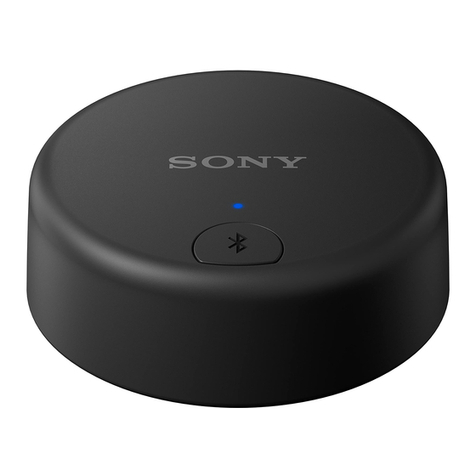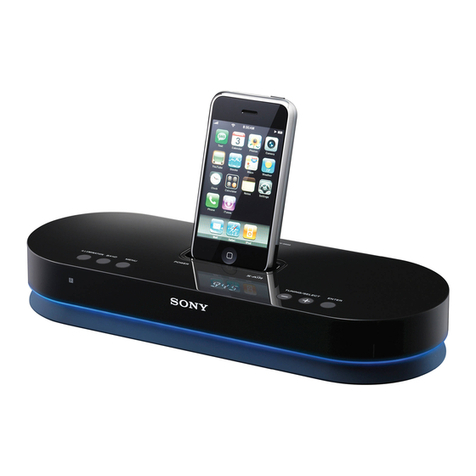
1-3
WRT-808A(U)
9US
Channel Setting
Caution
Turn off the transmitter when setting the transmitting
channel to eliminate interference or noise on other wireless
equipment.
Each
“Wireless Channel”
is represented on the unit by a 2-
digit TV channel number followed by another 2-digit
number, for example: 69-05.
Set the channel select switches for the desired channel by
using a screw driver.
The left switch selects the TV band and the 10’s digit of the
transmitting channel. The right switch selects the 1’s digit of
the transmitting channel.
Example: when channel 69-05 is selected for U68 model
Set the left switch to “69” side “0”.
Set the right switch to “5” .
For the selectable wireless channels and frequencies, see
“Wireless Channel Lists” on pages L-1 to L-3.
Notes on batteries
•
Use new alkaline batteries, and check the recommended
“
useby” date on the bottom of the batteries.
•
Do not pair different types of batteries.
•
Always replace the two batteries together.
•
The batteries are not rechargeable.
•
Be careful to install the batteries with the correct polarity.
•
When not using the transmitter for a long period, remove
the batteries to avoid leakage. If the batteries do leak, clean
all leakage from the unit. Leakage left in the unit may cause
poor battery contact. If there seems to be poor battery
contact, consult your Sony dealer.
10US
Attach a
microphone
to the
microphone
connector.
To dettach a
microphone,
press the
microphone
release
button.
Notes
•
If the channel select switches are operated while the
transmitter is on, the POWER/BATT indicator flashes in
green as a warning.
•
If you set to any channel other than those listed in
“Wireless Channel Lists” on pages L-1 to L-3, the
POWER/BATT indicator flashes in green as a warning.
•
While the POWER/BATT indicator is flashing, the RF
output signal send from the transmitter becomes lower
than the usable level.
While POWER/BATT indicator on the transmitter is
flashing, the RF input indicator on the tuner may light, if
the transmitter locates near the tuner.
Though the RF input indicator lights on the tuner, the
Sony tuner (equipped with muting function) makes neither
noise nor audio output.
•
Make sure that the channel selected is the same as that
selected on the tuner used in the same system.
•
If there is a TV broadcasting station near by, do not use
the station's channel.
Microphone System
Operation
Channel setting
Microphone connection
If noise is heard
Depending on the environment where the system is
installed, outside noise or radio wave may disrupt the
transmission of certain channels.
To select a channel under this circumstance, turn off the
transmitter. Select a channel on the tuner, at which the RF
indicator is off. (A channel free from noise or radio wave
interference is selected.) Then, set the same channel on the
transmitter.
Sony microphones
F-780/740/730/720/
710, etc.
11US
Use of RF power output switch
The RF power output switch (located inside of the battery
compartment) selects the RF power output either 50 mW or
10 mW. In normal use, set the switch to “50” (factory preset
position).
50 mW output is suitable for optimum transmission over
long working distance.
10 mW output will be suitable for multi-channel operation
to eliminate the interference.
Use of input LEVEL control
When the AF/PEAK indicator lights in green continuously,
the supplied audio signal is continuously over the reference
level. If this occurs, use the input LEVEL control to avoid
sound distortion.
By turning the control to “–10”, the WRT-808A provides 50
dB input attenuation and can be inputted +4 dB (maximum
20 dB) line level signal.
Notes on microphone system operation
•
To operate with two or more channels, maintain a distance
of at least 30 cm (one ft.) between each pair of
transmitters.
For details of operation with two or more channels, refer
to the Operating Instructions for the WRR-800A/801A/
805A, etc.
•
Ensure that the transmitter set to channels not being used
are either turned off or set to the minimum output level.
•
When powering the transmitter on or off, to keep the noise
to a minimum, set the audio output level from the tuner or
mixer to a minimum.
•
Powering the transmitter on without checking the channel
selection first may interfere with the operation of other
microphones/transmitters, if the current setting is already
being used.
•
To prevent noise generation, keep the transmitters at least
3m (10 feet) away from the tuner antennas when the
system is operated using a group which allows selection of
up to 11 channels.
•
Do not grip the transmitter while using as it
will significantly degrade good
performance, causing dropouts, etc. Hold
the microphone itself as shown.
12US
Specifications
Transmitter and modulation section
Oscillator Crystal controlled PLL synthesizer
Carrier frequencies
U64 model: 770.125 to 781.875 MHz
(94 settings at 125 kHz
intervals)
U66 model: 782.125 to 793.875 MHz
(94 settings at 125 kHz
intervals)
U68 model: 794.125 to 805.875 MHz
(94 settings at 125 kHz intervals)
RF power output 50 mW/10 mW selectable
Frequency stability Within ±0.005%
Tone signal 32.768 kHz
Type of emission 110KF3E
Type of antenna Internal, 1/4- wave length wire
Pre-emphasis 50µs
Deviation ±5 kHz (–60 dBV
1)
, 1 kHz input,
with 0 dB audio attenuation)
Frequency response 70 to 15,000 Hz
Signal-to-noise ratio 57 dB or more
(A-weighted, with reference
deviation at WRR-800A/801A)
Audio attenuator 0 to 50 dB
Maximum input +26 dBV (1 kHz, with 50 dB audio
attenuation)
Power section
Power requirements 3.0 V DC
(two LR6/size AA alkaline
batteries)
Battery life Approx. 4 hours at 25° C (77° F)
with Sony LR6 alkaline batteries
General
Operating temperature 0° C to +50° C (32° F to 122° F)
Storage temperature –30° C to +60° C (–22° F to +140° F)
Dimensions 40 ×108 ×40 mm (w/h/d)
(1
5
/
8
×4
3
/
8
×1
5
/
8
inches)
Mass Approx. 175 g (6 oz) including
batteries
Supplied accessory
Operating Instructions (1)
Design and specifications are subject to change without
notice.
. . . . . . . . . . . . . . . . . . . . . . . . . . . . . . . . . . . . . . . . . . . . . . . . . . . . . . . . . . . . . . . . . . . . . . . . . . . . . . . . . . . . . . . . . . . . . . . . . . . . . . . . . . . . . . . . . . . . . . . . . . . . . . .
1) 0 dBV = 1 Vrms
